|
||||||||||
|
|
||||||||||
|
||||||||||
|
|
||||||||||
At least three dozen serious accidents and incidents involving atomic or nuclear weapons have occurred since 1950. Many of these cases cost the lives of military personnel, led to the release of radioactive material, or resulted in the loss of the weapon itself. Most of these weapons fell into the ocean where the nuclear material could not be recovered given the limits of current technology. It is estimated that over 50 nuclear warheads have been lost in the world's oceans following aircraft or naval accidents. Another 26 nuclear reactors from ships and submarines have also been lost or deliberately dumped at sea.
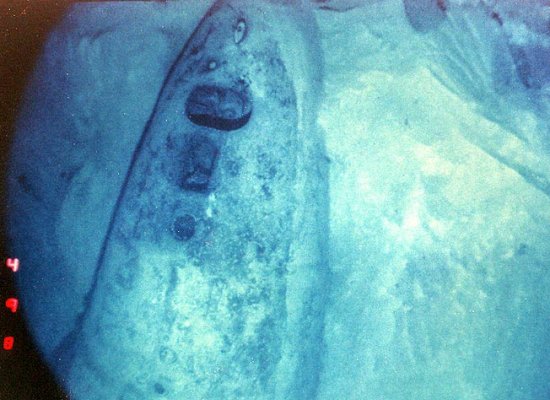
Before explaining these accidents in greater detail, it is helpful to explain how a nuclear accident or incident is categorized. The US Department of Defense has adopted the following definitions.
Nuclear Weapon Accident: An unexpected event involving nuclear weapons or nuclear weapons components that results in any of the following.
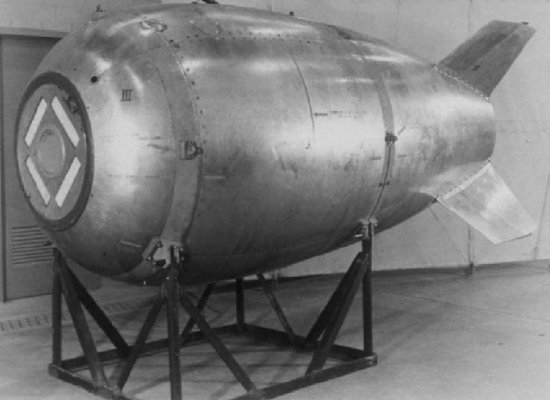
13 February 1950: While flying a simulated combat mission from Eielson Air Force Base in Alaska to Carswell AFB in Texas, a B-36 Peacemaker bomber experienced engine problems. The aircraft was carrying a single Mk 4 atomic bomb containing depleted uranium, but the plutonium core required for a fission reaction had been removed. Ice buildup on the carburetors forced the pilot to shut down three engines and reduced the power output of the remaining three. As weather conditions continued to worsen, the crew decided to abandon the aircraft. The unarmed bomb was jettisoned over the Pacific Ocean and its conventional explosives either detonated in mid-air or upon impact with the water. The plane then turned over a nearby island where the crew bailed out. Twelve were rescued from the frigid conditions but five were never found. The B-36 apparently continued on autopilot for a considerable distance before crashing in northern British Columbia. The wreck was later located and studied to confirm that no nuclear material remained aboard.
11 April 1950: All thirteen crewmembers aboard an American B-29 Superfortress were killed when their plane crashed near Kirtland AFB in New Mexico shortly after takeoff. The bomber had been carrying an atomic bomb with its nuclear core stored separately and four spare detonators. The impact of the crash and a massive fire destroyed the outer casing of the bomb, and its high explosives detonated when exposed to burning fuel. Since the weapon was partially disassembled for safety, there was no chance of an atomic explosion. All nuclear components were recovered from the accident scene intact and no radiation leak was detected.
13 July 1950: A B-50 Superfortress from Biggs AFB in Texas was on a training flight when the bomber pitched nose down and crashed near Lebanon, Ohio. All sixteen crew were killed. The conventional high explosives of an onboard atomic weapon detonated on impact, but the plane carried no nuclear capsule.
5 August 1950: A US Air Force B-29 carrying an unarmed atomic bomb with no fissile core was taking off from Fairfield-Suisun AFB in California when the bomber experienced several malfunctions. While attempting an emergency landing, the plane crashed and burst into flames. The fire set off the bomb's high explosives killing 19 crewmembers and rescue personnel. Among the fatalities was Brigadier General Robert Travis, and the base was later renamed in his honor.
10 November 1950: A B-50 Superfortress was ferrying a Mk 4 atomic weapon from Canada to a base in the United States when it suffered engine trouble. Fearing they could not make an emergency landing while carrying the heavy weapon, the crew jettisoned the bomb over the St. Lawrence River off the shore of Quebec. The weapon was set to self-destruct and detonated in mid-air. A plutonium core was not installed but the explosion scattered some 100 lb (45 kg) of depleted uranium across the river below.
10 March 1956: A B-47 Stratojet of the US Air Force disappeared while carrying the cores of two nuclear weapons in special transport cases. The aircraft was on a non-stop flight eastward from MacDill Air Force Base in Florida to an overseas base. Two in-flight refuelings were scheduled along the way. While the first was completed successfully, the B-47 never reached the second tanker over the Mediterranean Sea. The plane presumably went down somewhere over the Mediterranean but no trace of the plane, its crew, or its nuclear payload was ever found despite an extensive search.
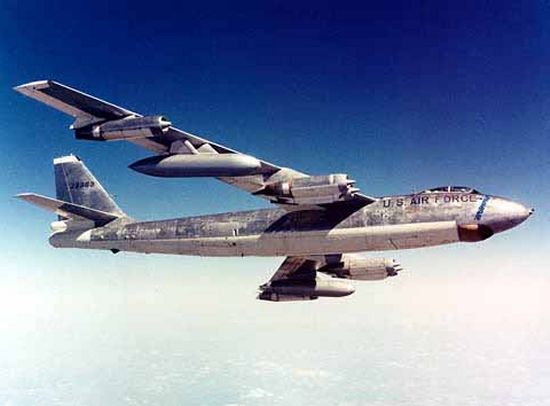
27 June 1956: An accident occurred at the NATO air base at Lakenheath, England, when an American B-47 bomber skidded off the runway and crashed into a storage igloo. The facility contained three Mk 6 atomic bombs but no nuclear cores. The weapons were quickly engulfed in flames by burning jet fuel from the B-47, but firefighters were able to extinguish the conflagration quickly. A bomb disposal expert on the scene concluded it was, "...a miracle that one Mark six with exposed detonators sheared didn't go."
22 May 1957: An Air Force B-36 bomber was ferrying a Mk 17 bomb weighing 42,000 lb (19,050 kg) from Biggs AFB in Texas to Kirtland AFB in New Mexico. During the landing approach, the bomb broke loose and tore part of the bomb bay doors off the plane as it fell. Although a retarding parachute deployed, it had little effect because of the plane's low altitude. The bomb's conventional explosives detonated as it impacted in a cow pasture in Albuquerque just south of the base. The blast completely destroyed the bomb leaving a large crater 12 ft (3.6 m) deep and 25 ft (7.6 m) across. Debris was scattered over a wide area with some pieces found nearly a mile away. The weapon's nuclear capsule was aboard the plane but was carried separately eliminating the possibility of a nuclear detonation. Low levels of radioactivity were detected but were contained completely within the impact crater.
28 July 1957: A C-124 Globemaster II cargo plane of the US Air Force left Dover AFB in Delaware transporting three nuclear weapons and one fissile core stored separately. Shortly into the flight, the plane lost power to two engines. The crew determined the plane could not maintain flight with the weight of the cargo and decided to jettison two of the weapons overboard. The weapons sank off the coast of New Jersey and were never located. The C-124 was able to make an emergency landing near Atlantic City with the remaining weapon and nuclear capsule.
11 October 1957: A B-47 had just taken off from Homestead AFB in Florida when one of its outrigger tires exploded. The plane crashed and fire engulfed an atomic weapon and its nuclear core stored in a separate case. The fire smoldered for about four hours during which two low order detonations of the conventional explosives were observed. Much of the weapon had been destroyed but the nuclear capsule was recovered intact with no radiation released.
31 January 1958: The first accident involving a fully operational armed nuclear weapon occurred at a base in Morocco. A B-47 was conducting a simulated takeoff when one of its landing gear wheels failed and the plane's tail struck the ground. The impact ruptured one of the bomber's fuel tanks causing a fire. The onboard bomb was damaged but did not detonate after lying in a smoldering fire for seven hours. Some radioactive contamination was detected in the immediate vicinity but was cleaned.
5 February 1958: An Air Force B-47 Stratojet from Homestead AFB was on a simulated combat mission when the plane collided with an F-86 Sabre near Savannah, Georgia. The B-47 was carrying one Mk 15 hydrogen bomb without its core at the time of the accident. The plane made three unsuccessful landing attempts at Hunter Air Force Base before the weapon was jettisoned over the Atlantic Ocean to avoid the risk of a high explosive detonation at the base. The bomb was dropped several miles from the mouth of the Savannah River in Wassaw Sound off Tybee Island. Though an intensive nine-week search was launched using divers and sonar equipment, the weapon was never found. Another unsuccessful search was mounted in 2001, and reports of radiation detected less than a mile from shore led to speculation of the bomb's discovery in 2004. Further investigation concluded the radioactivity was naturally occurring and the weapon remains missing.
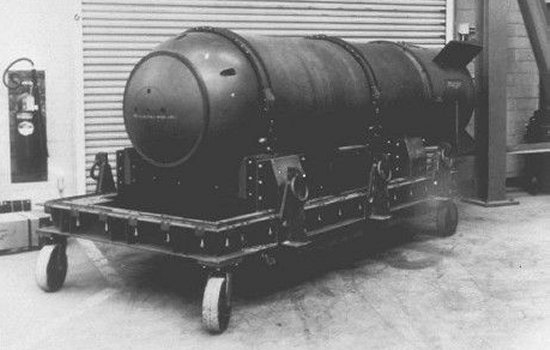
11 March 1958: A B-47E carrying an unarmed atomic weapon without a fissile core departed Savannah, Georgia, on a routine training flight. While flying over Florence, South Carolina, the bomb lock failed and the warhead fell onto a house in the suburban neighborhood below. The impact set off the conventional explosives causing several injuries on the ground.
4 November 1958: While taking off from Dyess AFB in Texas, a B-47 bomber of the US Air Force caught fire. The three crew ejected, although one was killed, and the plane crashed while carrying one atomic weapon. The conventional explosives were set off by the crash creating a large crater, but all nuclear components were recovered.
26 November 1958: A B-47 Stratojet caught fire while on the ground at Chennault AFB in Louisiana. The conflagration destroyed an onboard weapon releasing some radioactive contamination in the immediate vicinity of the wreckage.
18 January 1959: An American F-100 Super Sabre was on the ground conducting a practice alert at a base in the Pacific. The aircraft was carrying three external fuel tanks and a nuclear weapon without a nuclear capsule. As the starter button was depressed, the external fuel tanks were accidentally jettisoned causing an explosion. The fire was put out quickly and no contamination was detected.
6 July 1959: While taking off from Barksdale AFB in Louisiana, a C-124 transport carrying one nuclear weapon crashed. The resulting fire destroyed the weapon but safety devices prevented any nuclear or conventional explosions. A small amount of radioactive contamination was found directly beneath the weapon.
25 September 1959: A P-5M Marlin patrol aircraft of the US Navy was conducting a mission off Whidbey Island, Washington, while carrying one unarmed nuclear depth charge without its fissile core. The aircraft crashed into Puget Sound and the weapon was never recovered.
12 October 1959: An American B-52 Stratofortress had rendezvoused with a KC-135 Stratotanker near Hardinsberg, Kentucky. As the B-52 was being refueled, the two planes collided. Five of the bomber's nine crew and all four aboard the tanker were killed. The B-52 also carried two unarmed nuclear weapons that were recovered intact with little or no damage.
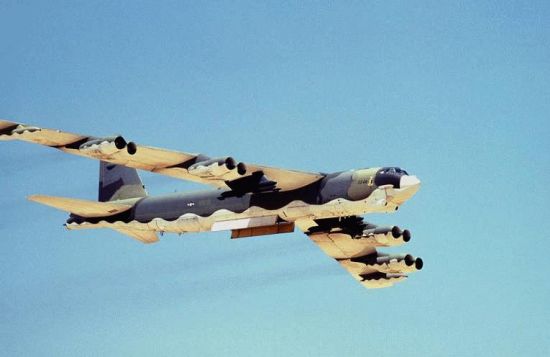
7 June 1960: A BOMARC air defense missile in storage at McGuire Air Force Base in New Jersey was destroyed after a high-pressure helium tank burst. The blast ruptured the missile's fuel tanks and ignited a large fire. Although the warhead was also destroyed, its high explosives did not detonate and contamination was limited to a small area.
24 January 1961: An Air Force B-52 was carrying two 20-megaton Mk 39 hydrogen bombs while on airborne alert over North Carolina. While flying at an altitude of 10,000 ft (3,050 m), leaking fuel in the right wing caused a mid-air explosion and a major structural failure. The wreckage fell to Earth near Goldsboro killing three of eight crew, and the two weapons came free of the plane as it broke apart. One of the bombs deployed its parachute and landed with minimal damage. The second, however, struck the ground and broke apart spreading its components over a wide area. Reports suggest the weapon nearly detonated since five of its six safety devices failed and only a single switch prevented a catastrophe. The Air Force launched a massive search of the area and recovered the bomb's plutonium, but most of the thermonuclear stage including highly enriched uranium was never found. To prevent its accidental discovery at a later date, the service purchased and fenced off the property and monitors it regularly for radiation. The accident prompted the US to develop improved safeguards to prevent accidental nuclear detonations, and the Soviet Union was encouraged to do likewise.
14 March 1961: A failure of the pressurization system aboard a B-52 and lack of fuel forced the crew to abandon the bomber near Yuba City, California. Two nuclear weapons aboard the plane were torn loose when it struck the ground, but safeguards worked properly and prevented any detonation. No radioactive contamination was released.
4 June 1962: The United States attempted its first high-altitude atmospheric nuclear test by placing a nuclear device atop a Thor rocket. The rocket was launched from Johnston Atoll in the Pacific Ocean but the tracking system failed during flight and the rocket had to be destroyed. The rocket's nuclear payload is believed to have vaporized before reaching the ocean.
20 June 1962: A second attempt to detonate a nuclear weapon at high altitudes also failed when the Thor booster rocket shut down prematurely a minute after launch. The vehicle had to be destroyed at an altitude of about 35,000 ft (10,670 m) above Johnston Atoll. The nuclear device being tested also fell into the Pacific Ocean and was not recovered, but pieces of debris contaminated by plutonium were found around the island.

10 April 1963: The USS Thresher (SSN-593) was an American nuclear-powered attack submarine. While on a test to its maximum diving depth, an accident occurred that caused the vessel to sink in the Atlantic Ocean about 220 miles (355 km) east of Cape Cod, Massachusetts. The leading theory is a pipe in the engine room ruptured under the great pressure at its depth causing the nuclear reactor to shut down. Without power, the Thresher had no ability to surface and continued diving until the increasing water pressure crushed the hull. It is not believed the submarine was carrying any nuclear weapons at the time of its sinking but the Thresher did take its reactor and 129 men to the ocean floor 8,400 ft (2,560 m) deep. Later investigation of the wreckage indicated the Thresher had been violently torn apart as it sank but the reactor compartment remained intact. The accident led to a major program to improve the quality of welding in submarine hulls that has been successful to this day.
13 November 1963: The US Atomic Energy Commission operated a facility in Medina, Texas, where obsolete nuclear weapons were disassembled. An explosion in a storage igloo at the site involved 123,000 lb (55,800 kg) of high explosive components causing minor injuries to three employees. Low levels of radioactive contamination from nuclear components stored in another part of the structure was detected.
13 January 1964: A B-52D bomber enroute from Massachusetts to Georgia crashed near Cumberland, Maryland, due to strong turbulence and structural failure. Only two of the five crewmembers survived. The plane was carrying two nuclear weapons in a ferry configuration, and these were recovered with minor damage.
21 April 1964: The United States had launched a Transit-5BN-3 nuclear-powered navigational satellite that failed to reach orbit and burned up over the Indian Ocean. The satellite's nuclear reactor partially burned during re-entry releasing small amounts of plutonium into the stratosphere. The remainder of the reactor fell into the ocean.
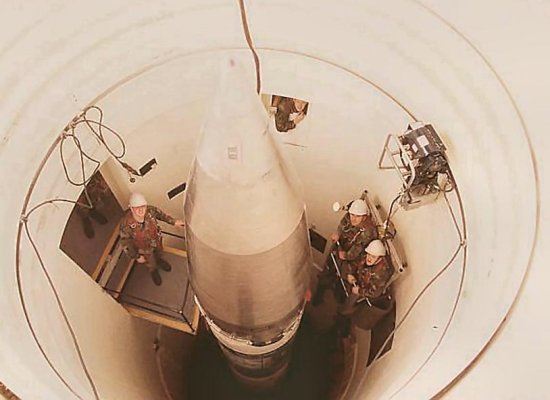
5 December 1964: During maintenance operations at a Minuteman I nuclear missile silo in South Dakota, a retrorocket below the Re-entry Vehicle (RV) fired and caused the RV to fall about 75 ft (20 m) to the silo floor. The RV's arming and fusing system was torn loose removing power, and safety devices prevented any possibility of detonation. Although the RV was damaged considerably by the fall, no radioactive contamination escaped.
8 December 1964: A B-58 Hustler bomber was taxiing into position for takeoff at what became Grissom AFB in Indiana when it slid off the runway and caught fire. The three crew ejected but one perished due to a hard impact of his escape capsule. Five nuclear weapons were aboard the plane and several were damaged in the fire. Contamination was released but confined to the immediate vicinity of the wreckage.
February 1965: The Soviet icebreaker Lenin suffered a nuclear reactor accident that fatally irradiated 30 crew. The vessel's nuclear fuel and other heavily contaminated materials were removed and dumped in Tsivoli Bay in 1967.
11 October 1965: Minor contamination occurred when a C-124 transport caught fire as it was being fueled at Wright-Patterson AFB in Ohio. The plane was carrying nuclear weapon components but no complete weapons. The contamination was removed by normal cleaning.
5 December 1965: The US Navy aircraft carrier USS Ticonderoga was returning from a Vietnam deployment to the naval base at Yokusuka, Japan. While cruising about 70 miles (110 km) from the Ryukyu Islands, an A-4E Skyhawk attack plane rolled over the side of the ship with its pilot aboard. The plane was carrying one B-43 thermonuclear bomb at the time. The plane, its pilot, and the bomb sank in water 16,000 ft (4,875 m) deep and could not be recovered. Because of the great pressure at that depth, some have expressed concern that the weapon might have imploded spreading radioactive material, but there is no evidence this occurred.
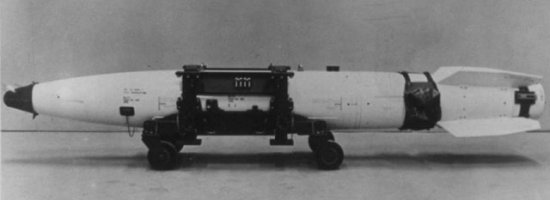
17 January 1966: One of the most embarrassing accidents in the history of nuclear weapons occurred when a B-52 Stratofortress carrying four B-28 thermonuclear bombs suffered a mid-air collision with a KC-135 tanker. The B-52 was on airborne alert and conducting a routine air refueling while returning to Seymour Johnson AFB in North Carolina. The bomber was attempting its third refueling over the village of Palomares, Spain, when the nozzle of the tanker's boom struck the plane. The boom ripped open the B-52 causing it to break into pieces while the KC-135's payload of jet fuel exploded, destroying the aircraft and killing its crew of seven. The debris of the two planes scattered over 100 square miles (260 sq km). One of the bomber's four weapons came down on land with minor damage while a second was lost in the ocean. This Broken Arrow was later recovered intact after one of the largest search and recovery operations ever mounted. The three month search required 33 ships and over 3,000 Navy personnel before the weapon was recovered. While these two weapons suffered little damage, the high explosive casing of the other two bombs detonated upon impacting land spreading low levels of radioactive contamination over Palomares and the surrounding countryside. Under pressure from the local inhabitants, the US collected and transported 1,400 tons of contaminated soil and vegetation from Spain to the United States for storage.
Early 1967: Although the date and details remain a mystery, the Soviet icebreaker Lenin suffered a second nuclear reactor accident. The vessel had to be abandoned for over a year until radiation levels dropped low enough for repairs to be made. The ship's three reactors were removed and dumped into the Kara Sea. Two new reactors were installed and the ship re-entered service in 1970.
21 January 1968: An American B-52 from Plattsburgh AFB in New York was on airborne alert in the Arctic Circle when a fire broke out in the navigator's compartment. As the plane approached Thule AFB in Greenland to attempt an emergency landing, it crashed about 7 miles (11 km) southwest of the runway while carrying four nuclear bombs. The B-52 burst into flames as it impacted causing the high explosive casing on at least one of the weapons to detonate. The blast spread radioactive plutonium from the bomb's inner core about 1,000 ft (305 m) to either side of the wreck. Due to the intensity of the fire, two of the four bombs fell through the melting ice and sank to the ocean floor. One of these Broken Arrows was not recovered until 1979, and the second weapon remains lost on the floor of Baffin Bay.
11 April 1968: The Soviet Golf II class diesel-powered ballistic missile submarine K-129 sank over 16,000 ft (4,875 m) deep in the Pacific Ocean several hundred miles northwest of Hawaii. The entire crew of 98 was lost and the vessel sank with three ballistic nuclear missiles plus two nuclear torpedoes. The reason for the sinking is unknown, but evidence suggests an explosion in the battery compartment or a missile tube. In one of the most amazing tales of the Cold War, America's Central Intelligence Agency launched "Project Azorian" to recover the vessel and its nuclear weapons from the deep seabed. The CIA secretly funded the construction of a massive ship called the Glomar Explorer that was ostensibly built for undersea mining. In reality, the vessel carried an enormous crane designed to grapple the Soviet submarine and lift it to the surface for study. It is unknown how successful the effort was, but the US has admitted to recovering at least a portion of K-129.
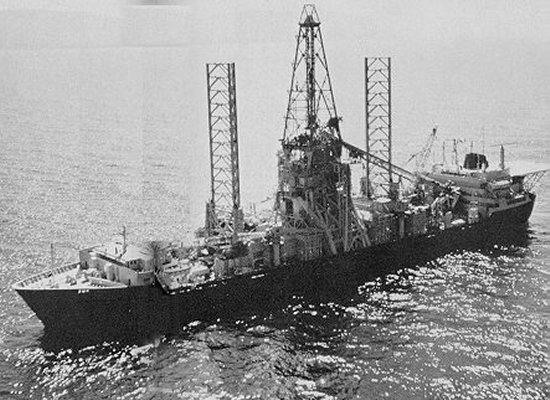
18 May 1968: An American attempt to launch the spacecraft Nimbus B-1 failed when the booster rocket had to be destroyed at an altitude of 18.5 miles (30 km). The satellite carried two radioisotope generators that fell into the ocean off the California coast. The nuclear material was recovered intact from a depth of 330 ft (100 m) with no release of radioactivity.
21 May 1968: The attack submarine USS Scorpion (SSN-589) was returning to the United States following a three month deployment when the vessel sank in the Atlantic Ocean about 500 miles (805 km) southwest of the Azores. While details of the sinking remain a mystery, one theory is a battery within one of the submarine's torpedoes overheated and ignited. The subsequent fire caused a warhead detonatation and blasted open the torpedo loading hatch at the top of the forward compartment. A flood of water through this hatch sent the Scorpion over 10,000 ft (3,050 m) deep to the ocean floor. The vessel broke into two major sections as it sank with the forward hull containing the torpedo room and control spaces located some distance from the aft hull containing the reactor. The Scorpion was lost with its entire crew of 99, one nuclear reactor, and two nuclear-tipped torpedoes. The US Navy continues to monitor the wreck for signs of disturbance and environmental impact but no release of radioactive material has been detected to date.
24 May 1968: Soviet November class submarine K-27 was conducting sea trials when the reactor overheated and began spreading radiation through the vessel. Of those aboard, 10 were killed and another 12 suffered severe radiation sickness. Never repaired, the contaminated submarine remained in port for over a decade until its reactor compartment was filled with a thick mixture of sealant. The entire submarine and its still fueled reactors were then scuttled 110 ft (35 m) deep at Stepovoy Bay in the Kara Sea in 1982. Proposals exist to raise and dispose of the wreck in hopes of avoiding contamination in such shallow waters.
12 April 1970: The Soviet November class attack submarine K-8 sank to a depth of 14,000 ft (4270 m) in the Bay of Biscay about 300 miles (480 km) northwest of Spain. The vessel suffered a fire that broke out in two aft compartments. The captain's order to abandon ship was countermanded and the submarine sank in heavy seas, taking the lives of 52 members of its crew. K-8 was powered by two nuclear reactors and possibly carried multiple nuclear torpedoes. Rumors suggest that shortly before the sinking, K-8 laid tactical atomic torpedoes in the Bay of Naples for use as mines against the US fleet in case of war. The vessel was carrying 24 of these torpedoes and only four were found inside the sunken wreck. It is unknown whether the remainder still lie on the ocean floor near Italy or if the Soviets recovered them at a later date. Nevertheless, this tale is based largely on information from an Italian investigator named Mario Scaramella whose credibility has since become suspect. K-8 had also suffered an earlier reactor accident in 1960 that contaminated the vessel and injured several crewmen.
17 April 1970: As Apollo 13 returned to Earth following its aborted mission to the Moon, the crew jettisoned a radioisotope thermoelectric generator (RTG) that would have been left on the lunar surface had the landing been successful. The RTG, containing plutonium, survived re-entry and came to rest in the Tonga Trench at the bottom of the Pacific Ocean where it still remains.
8 September 1977: The Soviet submarine K-171, a Delta I class ballistic missile boat, accidentally jettisoned one of its missiles overboard into the Pacific Ocean near Kamchatka. Pressure had been building up in the missile launch tube causing the missile and its nuclear warhead to be ejected. Though initially classified as a Broken Arrow, the warhead was later located and recovered following an intense search.
1978: A Soviet barge named Nikel was transporting low and medium level radioactive waste products when it sank during a storm sometime in 1978. The vessel was lost approximately 20 miles northwest of Kolguyev Island in the Barents Sea and no recovery attempts were made.
24 January 1978: The Soviet ocean reconnaissance satellite Kosmos 954 fell into the atmosphere and burned up over Canada. The satellite was powered by a nuclear reactor, but the majority was apparently destroyed in re-entry. Only small radioactive pieces were recovered.
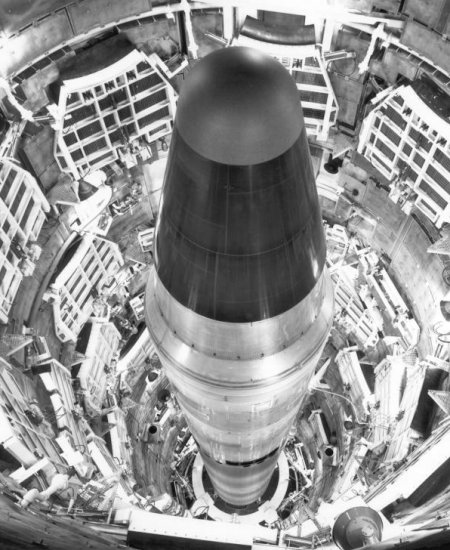
19 September 1980: While conducting routine maintenance on a Titan II ballistic missile at a silo in Arkansas, a repairman dropped a heavy wrench that punctured a pressurized fuel tank. The fuel vapor later ignited killing one and injuring 21 more US Air Force personnel. The blast also threw the missile's re-entry vehicle out of the silo, but it was recovered intact with no leak of radiation.
7 February 1983: A Soviet nuclear-powered reconnaissance satellite called Kosmos 1402 re-entered the atmosphere and burned up over the southern Atlantic Ocean. It is unknown whether the reactor survived intact, but the remains fell into the ocean about 1,000 miles (1,600 km) east of Brazil.
June 1983: Rumors indicate Soviet Victor III class attack submarine K-324 collided with another submarine, believed to be a Chinese Han class nuclear submarine. Though never confirmed, the K-324 crew claimed the Chinese vessel sank with its crew of 70. A 1989 Soviet survey reportedly detected high levels of radiation in the vicinity, and obituaries in Chinese newspapers may support the contention of many submarine designers perishing in an accident in 1983.
24 June 1983: The Soviet submarine K-429, a Charlie class nuclear-powered cruise missile submarine, sank in Savannaya Bay in the Bering Sea killing at least 16 of its 120 crew. The vessel has been ordered to conduct a submerged torpedo launch even though still undergoing maintenance. In the haste to put to sea, ventilation systems had not been properly sealed and ballast tank valves were left misaligned. As the submarine submerged in shallow waters for a test dive, the open ventilation system led to massive flooding in forward compartments. The captain attempted to resurface the vessel but was foiled by the faults in the ballast tank system. K-429 settled to the shallow seabed about 130 ft (40 m) down. Luckily, most of the crew was still alive and the vessel was equipped with escape capsules to reach the surface. Two crewmen volunteered to ascend into the frigid Arctic waters and swim ashore to summon help. Despite being arrested upon reaching the coast, the men were able to bring word of the sinking to naval commanders so a rescue attempt could be launched. With ships waiting above, the remainder of the crew used the escape capsules to ascend to the surface. The vessel was salvaged the following August recovering its single reactor and any nuclear weapons aboard. Though later returned to service, the vessel sank again at its moorings in September 1985 killing additional crewmen. K-429 was raised once more and finally retired.
6 October 1986: The Soviet Yankee I class ballistic missile submarine K-219 was on patrol off the Atlantic coast of the US when a missile tube began leaking. The incoming water mixed with liquid rocket propellants that had dripped from the missile to create toxic gases. The buildup of gases resulted in an explosion. Four crewmen perished while fighting the fires and the rest were forced to evacuate because of the toxic fumes. As the submarine was being towed back to port, it sank 680 miles (1,095 km) north of Bermuda taking two nuclear reactors and 15 nuclear missiles to the bottom (one missile tube was empty having been damaged and sealed after a previous leak). Each missile carried two warheads each and it is believed the submarine also held two nuclear torpedoes for a total of 32 nuclear warheads.

20 August 1987: The Soviet Union lost a radioisotope thermoelectric generator into the Sea of Okhotsk following an "emergency disposal." The RTG was never located.
7 April 1989: K-278 Komsomolets was a Soviet Mike class attack submarine. K-278 was submerged and returning to base when a fire broke out in the aft compartment. The fire spread forward along wires causing electrical short circuits that shut down the reactor. As the vessel began to lose buoyancy, the order was given to surface and abandon ship. Unfortunately, K-278 sank off the northern coast of Norway killing 42 of the 69 crewmembers. The submarine carried one nuclear reactor and two torpedoes with nuclear warheads. Later exploration of the wreck revealed large cracks running the length of the hull, major blowout damage to the forward torpedo compartment, and possible reactor damage. As radiation levels in the area began to rise and fearing further contamination in these rich fishing waters, Russia made several attempts to hermetically seal K-278 in a jelly-like material. The effort was declared successful in 1996, and monitoring of the wreck since has measured no significant radiation leaks. Nevertheless, the seal is expected to degrade by 2025.
16 November 1996: Mars 96 was a Russian probe launched to study the planet Mars. Following an unsuccessful burn of a booster rocket stage, the spacecraft fell back into Earth's atmosphere over the Pacific Ocean. The remains of the vehicle, containing 18 radioisotope thermoelectric generators, landed off the coast of Chile.
8 August 1997: While flying over the Sea of Okhotsk off the coast of Sakhalin Island, a Russian helicopter was forced to jettison a radioisotope thermoelectric generator it had been transporting. The RTG was not located despite a search.
12 August 2000: The Russian submarine K-141 Kursk, a cruise missile submarine of the Oscar II class, was participating in military exercises in the Barents Sea north of Russia when a massive explosion rocked the vessel. The blast ruptured the hull sending the Kursk into a terminal dive towards the sea floor 350 ft (105 m) down. Though 23 of the 118 crewmembers survived the initial sinking, attempts to rescue them failed. The men perished from lack of oxygen and the vessel had completely flooded by the time divers were able to enter the wreck. Subsequent investigations concluded the sinking was caused by a fire in the torpedo room. A torpedo's propellants ignited creating a large fire that soon caused the warheads of other torpedoes to detonate. The massive explosion ripped open the forward part of the submarine and quickly flooded the forward compartments. Russia indicated that no nuclear weapons were aboard, and the nuclear reactors were recovered in 2001 when the wreck was raised.
30 August 2003: K-159 was an aging Russian November class submarine retired in 1989. The vessel had already suffered a radiation accident in 1965 that was never adequately repaired, and the submarine remained laid up with virtually no maintenance for fourteen years. The hull was in such poor condition that pontoons were welded on to keep K-159 afloat, but these too were in a poor state and had been made in the 1940s. During the 1990s, foreign nations donated funds to have 16 abandoned Russian submarines towed to a shipyard for disposal. As K-159 was being moved, the submarine encountered a storm that tore the pontoons off. The boat eventually sank in 780 ft (240 m) of water with the loss of nine crew. The sunken vessel still carries two nuclear reactors and 1,800 lb (800 kg) of spent fuel. No radiation leakage has been detected so far, and plans to raise the wreck appear to have been postponed indefinitely.
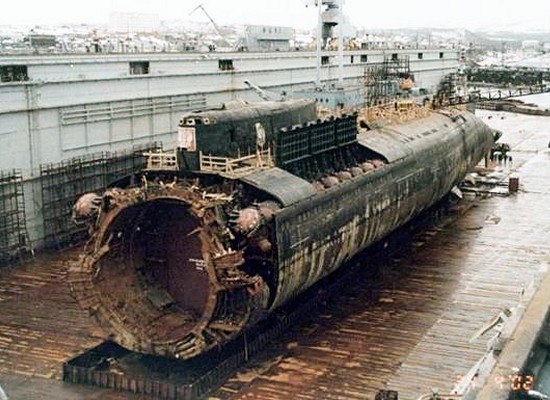
While the accidents described above are among the most serious ever experienced, many others not included here have
also resulted in reactor accidents, loss of life, or the spread of radioactive materials.
- answer by Jeff Scott, 2 April 2006
Read More Articles:


|
Aircraft | Design | Ask Us | Shop | Search |

|
|
| About Us | Contact Us | Copyright © 1997-2023 | |||
|
|
|||